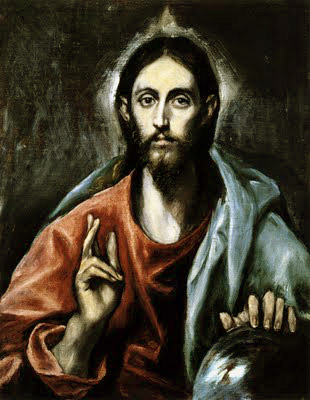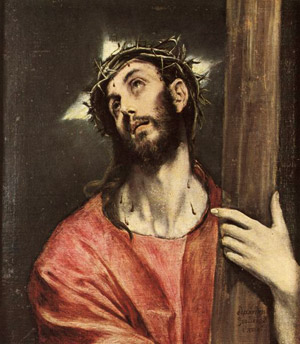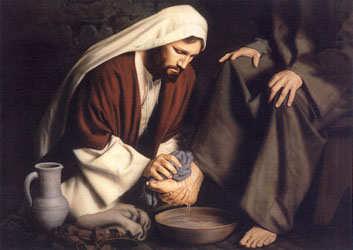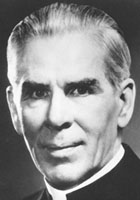December 2012 - Vol. 64  . .
The Son of Man . by Fulton J. Sheen (1895-1979) No title did our Lord use more often to describe himself than “the Son of Man.” No one else ever called him by that title, but he used it of himself at least eighty times. Nor is it “a Son of Man,” that he called himself, but “the Son of Man.” His existence, both eternal and temporal, is in it. In his conversation with Nicodemus he indicated that he was God in the form of man. There is One who came down from heaven;That “the Son of Man” referred to his human nature, which was in personal union with his divine nature, is evidenced from the fact that the first time our Lord ever referred to himself as “the Son of Man” was when he was recognized by his disciples as the Son of God. As God he could
not suffer
This distinction between the Son of Man and Son of God, he often made. On one occasion, when his enemies sought to kill him, he said: You belong to earth, I to heaven;  Christ Carrying the Cross, by El Greco As Son of Man
he suffered for us
What is written of the Son of Man?Because the name implied not only humiliation but identification with sinful mankind, he never used the term after he had redeemed humanity and risen from the dead. The glorified lips of the “Resurrection and the Life” never again pronounce “the Son of Man.” He had left behind him the oneness with unredeemed humanity. That the lowliness of his present condition was what he wished to emphasize became evident from his oneness with the woes and miseries of men. If men were homeless, he would be homeless: Foxes have holes,Since the truth he came to bring to this earth was reserved for those who accepted his divinity, and was not something to tickle ears, he never used “the Son of Man” as the source of that truth. The truth he brought was divine truth, final and absolute. Hence he avoided using the term “Son of Man” in relation to his divine nature, which was one with the Father. I have knowledge of him,  The best judge
of men and women
The Father…has also granted him powerThough “the Son of Man” expressed his federation with humanity, He was very careful to note that he was like man in all things save sin. He challenged his hearers to convict him of sin. But the consequences of sin were all his as “the Son of Man.” Hence the prayer to let the chalice pass. His endurance of hunger and thirst. His agony and bloody sweat. Perhaps even his seeming older than he actually was. His condescension to wash the feet of his disciples. His absence of resentment as the swine-owning capitalists ordered him from their shores. His endurance of false charges of being a winebibber, a glutton. His gentleness, which expressed itself in hiding when his enemies would have stoned him. Above all, his endurance of worry, anxiety, fear, pain, mental anguish, fever, hunger, thirst, and agony during the hours of His Passion. All these things were to inspire men to imitate “the Son of Man.” Nothing that was human was foreign to him. Human infirmity
touched him
He took our infirmities upon himself,Isaiah had prophesied this incorporation with human frailty. Though there is no evidence in the Gospels that our Lord was ever ill, there are many instances where he felt sickness as if it were his own, as he felt sin as if it were his own. Hence in the performance of a cure, He sometimes “sighed” or “groaned” after looking up to heaven, the source of his power. Human infirmity touched him so deeply, because deafness, dumbness, leprosy, insanity were the effects of sin, not in the person afflicted but in humanity. Because his death would remove sin which was the cause (though the final release from sickness and error would not come until the resurrection of the just), he said that it was just as easy for him to heal one as the other. Tell me, which command is more lightly given,He sighed because he was a High Priest who was touched by all the “ills that flesh is heir to.” Tears! He wept three times, because humanity weeps. When he saw others weep, such as Mary in grief at her brother’s death, he felt the sorrow as his own. When he saw her in tears,In the death and burial of Lazarus he saw the long procession of mourners from the first to the last. And the reason of it all – how death came into the world with the sin of Adam. Within a few days, he knew that he as the second Adam or “the Son of Man,” would take on “the sins of the world,” and thereby give death its death. The restoring of physical health to humanity cost him something, as the restoring of spiritual health cost his life. In the first instance, as the Son of Man, He felt as if an energy that was lost to him went into humanity. When the woman touched the hem of his garment, the Gospel records that he was: Inwardly aware of the powerGod chose to enter the human family Though, therefore, no disease or sin touched him by a contagion, he bore them as a loving mother bears the agony of her child and would, if possible, take it upon herself. But a mother does not have that representative character over her family that Christ had over the human race. He was the new Adam and could bring forgiveness and life to all men, as the first Adam brought to all men sin and death. Finally, the title “the Son of Man” meant that he was representative not of the Jews alone, nor of the Samaritans alone, but of all mankind. His relation to mankind was similar to that of Adam. The human race has two heads – Adam and the new Adam, Christ. “The Son of Man” was not a particular man, a personal man, but rather a Pattern Man, a Universal Man. It was into the human family that God chose to enter, the perfect phrase to describe it being, Homo factus est. He was made man and qualified himself for co-partnership with human nature. He entered into the reality of common humanity. He assumed a human nature into is sacred person. Aristotle said that if the gods take interest in human affairs, they may be expected to look with most satisfaction on what is most akin to their own nature. This would imply a certain amount of disdain for the human – hence the Greeks said that manifestations of deity “were too fair to worship, too divine to love.” But in the person of Christ it is the reverse that was true – “He came unto his own.” A sanctifier must be one with those whom he sanctifies. The very separateness in character between the two parties makes it necessary that in some way they should be one. There must be a point of contact, one with the other. He who is like his brethren will have more power over them than one who is not like them. Hence, in order to be a sanctifier, our Blessed Lord had to be a man like his unholy brethren. He would make them holy by reproducing in his life the lost ideal of human character and bringing that ideal to bear on their minds and hearts. A compassionate
high priest
He could not be a High Priest for man and intercede for man, and pay his debts to the Father, unless he was taken from among men. The title “Son of Man” proclaimed this brotherhood with men. But men cannot be brothers unless they have a common father, and God is not a Father unless he has a Son. To believe in the brotherhood of man without the Fatherhood of God would make men a race of bastards. But sympathy alone is not the full explanation of this title “Son of Man.” He was not only willing, but eager – even under a necessity – to come to their lot. Sympathetic love brought him down from heaven to earth, and fellowship in suffering followed as a matter of course. Love is a vicarious principle. A mother suffers for and with her sick child, as a patriot suffers for his country. No wonder that the Son of Man visited this dark, sinful, wretched earth by becoming Man – Christ’s unity with the sinful was due to his love! Love burdens itself with the wants and woes and losses and even the wrongs of others. He was sin-bearer
by destiny
In virtue of the divine “must,” he was not only a Priest but a Victim. He put away sin by the sacrifice of himself. As a Priest, he was humanity’s representative; as a Victim, he was humanity’s substitute. He offered himself as an acceptable sacrifice to God. It is a perfect example of self-surrender and devotion to the divine will, and God accepted the sacrifice not by a man, but by “the Son of Man,” or the human race represented by this Archetypal or Pattern Man. Acting as sin-bearer did not in any way alter his relationship to his heavenly Father. Though Christ was actually the sin-bearer only while on earth, he was the sin-bearer by destiny before he came into the world. Hence, Scripture calls him the “Lamb slain before the foundation of the world.” No one – not the demons, not his enemies, not even the Apostles – ever called him “the Son of Man.” As “Son of God” applied to himself had a unique meaning, namely, the only begotten Son of the Eternal Father, so had this title, coined by himself and applied to himself alone. No one else ever stood as a representative of the human race. “The Son of God” is a stranger to the human race, because he is its Creator; but the “Son of Man” was one with the human race except for its sin. As man he could die. To die is a humiliation; but to die for others is glorification. His Father, therefore, manifested a singular love to his divine Son by allowing him as the Son of Man to taste death for others. The family tree of earthly ancestors was really not important. What was important was the family tree of the children of God he planted on Calvary. [This article is adapted
from Life of Christ, Chapter 23, (c) by Archbishop Fulton J. Sheen
1958, published by Ignatius Press, San Francisco, with forward by Fr. Benedict
Groeschel. Used with permission.]
|
. | |||
|
publishing address: Park Royal Business Centre, 9-17 Park Royal Road, Suite 108, London NW10 7LQ, United Kingdom email: living.bulwark@yahoo.com |
. |
